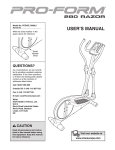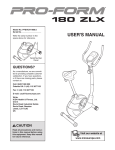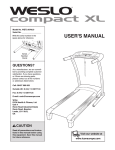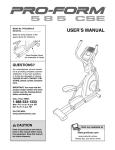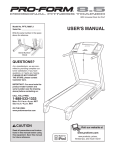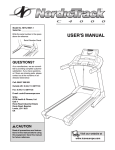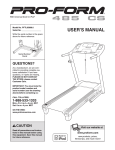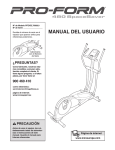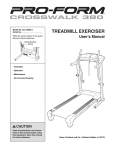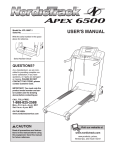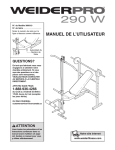Download Weslo Momentum 2000 Elliptical User`s manual
Transcript
Model No. WLEVEL72808.0 Serial No. Write the serial number in the space above for reference. Serial Number Decal QUESTIONS? As a manufacturer, we are committed to providing complete customer satisfaction. If you have questions, or if there are missing parts, please contact us at the numbers or addresses listed below: Call: 08457 089 009 Outside UK: 0 (44) 113 3877133 Fax: 0 (44) 113 3877125 E-mail: [email protected] Write: ICON Health & Fitness, Ltd. Unit 4 Revie Road Industrial Estate Revie Road, Beeston Leeds, LS11 8JG UK CAUTION Read all precautions and instructions in this manual before using this equipment. Keep this manual for future reference. USERʼS MANUAL TABLE OF CONTENTS WARNING DECAL PLACEMENT . . . . . . . . . . . . . . . . . . . . . . . . . . . . . . . . . . . . . . . . . . . . . . . . . . . . . . . . . . . . . .2 IMPORTANT PRECAUTIONS . . . . . . . . . . . . . . . . . . . . . . . . . . . . . . . . . . . . . . . . . . . . . . . . . . . . . . . . . . . . . . . .3 BEFORE YOU BEGIN . . . . . . . . . . . . . . . . . . . . . . . . . . . . . . . . . . . . . . . . . . . . . . . . . . . . . . . . . . . . . . . . . . . . . .4 ASSEMBLY . . . . . . . . . . . . . . . . . . . . . . . . . . . . . . . . . . . . . . . . . . . . . . . . . . . . . . . . . . . . . . . . . . . . . . . . . . . . . . .5 HOW TO USE THE ELLIPTICAL EXERCISER . . . . . . . . . . . . . . . . . . . . . . . . . . . . . . . . . . . . . . . . . . . . . . . . . .10 MAINTENANCE AND TROUBLESHOOTING . . . . . . . . . . . . . . . . . . . . . . . . . . . . . . . . . . . . . . . . . . . . . . . . . . .14 EXERCISE GUIDELINES . . . . . . . . . . . . . . . . . . . . . . . . . . . . . . . . . . . . . . . . . . . . . . . . . . . . . . . . . . . . . . . . . . .15 PART LIST . . . . . . . . . . . . . . . . . . . . . . . . . . . . . . . . . . . . . . . . . . . . . . . . . . . . . . . . . . . . . . . . . . . . . . . . . . . . . .18 EXPLODED DRAWING . . . . . . . . . . . . . . . . . . . . . . . . . . . . . . . . . . . . . . . . . . . . . . . . . . . . . . . . . . . . . . . . . . . .19 ORDERING REPLACEMENT PARTS . . . . . . . . . . . . . . . . . . . . . . . . . . . . . . . . . . . . . . . . . . . . . . . . . .Back Cover WARNING DECAL PLACEMENT This drawing shows the location(s) of the warning decal(s). If a decal is missing or illegible, call the telephone number on the front cover of this manual and request a free replacement decal. Apply the decal in the location shown. Note: The decal(s) may not be shown at actual size. WESLO is a registered trademark of ICON IP, Inc. 2 IMPORTANT PRECAUTIONS WARNING: To reduce the risk of serious injury, read all important precautions and instructions in this manual and all warnings on your elliptical exerciser before using your elliptical exerciser. ICON assumes no responsibility for personal injury or property damage sustained by or through the use of this product. 8. Wear appropriate exercise clothes when exercising; do not wear loose clothes that could become caught on your elliptical exerciser. Always wear athletic shoes for foot protection. 1. Before beginning any exercise program, consult your physician. This is especially important for persons over the age of 35 or persons with pre-existing health problems. 2. It is the responsibility of the owner to ensure that all users of the elliptical exerciser are adequately informed of all precautions. 9. Hold the handgrip pulse sensor or the handlebars when mounting, dismounting, or using your elliptical exerciser. 3. Your elliptical exerciser is intended for home use only. Do not use your elliptical exerciser in a commercial, rental, or institutional setting. 10. Keep your back straight while using your elliptical exerciser; do not arch your back. 11. The pulse sensor is not a medical device. Various factors, including the userʼs movement, may affect the accuracy of heart rate readings. The pulse sensor is intended only as an exercise aid in determining heart rate trends in general. 4. Keep your elliptical exerciser indoors, away from moisture and dust. Place your elliptical exerciser on a level surface, with a mat beneath it to protect the floor or carpet. Make sure that there is enough clearance around your elliptical exerciser to mount, dismount, and use it. 12. When you stop exercising, allow the pedals to slowly come to a stop. 5. Inspect and properly tighten all parts regularly. Replace any worn parts immediately. 13. If you feel pain or dizziness while exercising, stop immediately and cool down. 6. Keep children under age 12 and pets away from your elliptical exerciser at all times. 14. Use your elliptical exerciser only as described in this manual. 7. Your elliptical exerciser should not be used by persons weighing more than 250 lbs. (113 kg). 3 BEFORE YOU BEGIN cover of this manual. To help us assist you, note the product model number and serial number before contacting us. The model number and the location of the serial number decal are shown on the front cover of this manual. Congratulations for selecting the new WESLO® MOMENTUM 2000 elliptical exerciser. The MOMENTUM 2000 elliptical exerciser provides a wide array of features designed to make your workouts at home more effective and enjoyable. For your benefit, read this manual carefully before you use the elliptical exerciser. If you have questions after reading this manual, please see the front Before reading further, please familiarize yourself with the parts that are labeled in the drawing below. Handlebar Console Pulse Sensor Pedal Disc Pedal 4 ASSEMBLY Assembly requires two persons. Place all parts of the elliptical exerciser in a cleared area and remove the packing materials. Do not dispose of the packing materials until assembly is completed. In addition to the included tools, assembly requires a Phillips screwdriver wrench , a rubber mallet , and pliers . , an adjustable As you assemble the elliptical exerciser, use the drawings below to identify small parts. The number in parentheses below each drawing is the key number of the part, from the PART LIST near the end of this manual. The number following the parentheses is the quantity needed for assembly. Note: Some small parts may have been preassembled. If a part is not in the hardware kit, check to see if it has been preassembled. M6 Locknut (27)–4 M10 Locknut (33)–6 M6 x 12mm Screw (43)–4 Wave Washer (58)–2 M10 Split Washer (59)–2 M6 x 48mm Flat Head Screw (36)–4 M10 Washer (35)–2 M10 x 25mm Patch Screw (22)–2 Pedal Arm Bolt Set (40)–2 M6 x 36mm Button Bolt (50)–4 M10 x 68mm Button Bolt (48)–2 M10 x 70mm Carriage Bolt (34)–4 5 1. 1 To make assembly easier, read the information on page 5 before you begin assembling the elliptical exerciser. 34 Identify the Front Stabilizer (10), which is narrower than the Rear Stabilizer (not shown). While another person lifts the front of the Frame (1), attach the Front Stabilizer to the Frame with two M10 x 70mm Carriage Bolts (34) and two M10 Locknuts (33). 33 10 2. While another person lifts the back of the Frame (1), attach the Rear Stabilizer (28) to the Frame with two M10 x 70mm Carriage Bolts (34) and two M10 Locknuts (33). 1 33 2 33 33 3. The Console (23) can use four “AA” batteries (not included); alkaline batteries are recommended. IMPORTANT: If the Console has been exposed to cold temperatures, allow it to warm to room temperature before inserting batteries. Otherwise, you may damage the console displays or other electronic components. Remove the battery cover, insert the batteries into the battery compartment, and reattach the battery cover. Make sure to orient the batteries as shown by the diagram inside the battery compartment. 3 1 34 Batteries 23 6 28 Battery Cover 4. While another person holds the Console (23) near the Upright (2), connect the console wire to the Upper Wire (44). Then, insert the wires into the Upright. 4 23 Tip: Avoid pinching the wires. Attach the Console (23) to the Upright (2) with four M6 x 12mm Screws (43). Console Wire 44 2 43 5. While another person holds the Upright (2) near the Frame (1), connect the Upper Wire (44) to the Lower Wire (63). Then, push the excess wire downward into the Frame. Avoid pinching the wires 5 Tip: Avoid pinching the wires. Slide the Upright (2) onto the Frame (1). Attach the Upright with two M10 x 68mm Button Bolts (48), two M10 Split Washers (59), and two M10 Locknuts (33). Do not tighten the Button Bolts yet. 33 2 59 44 63 1 7 48 Avoid pinching the wires 6. Identify the Left Handlebar (6), which is marked with a sticker. Insert the Left Handlebar into one of the Handlebar Arms (5); make sure that the Handlebar Arm is turned so the hexagonal holes are on the indicated side. 6 Attach the Left Handlebar (6) to the Handlebar Arm (5) with two M6 x 36mm Button Bolts (50) and two M6 Locknuts (27). Make sure that the Locknuts are inside the hexagonal holes. Do not fully tighten the Button Bolts yet. 8 2 Grease 6 Apply a small amount of the included grease to the left axle on the Upright (2). 49 Make sure that there are two Small Handlebar Bushings (49) in the Left Handlebar (6). Slide a Handlebar Spacer (47) and the Left Handlebar onto the left axle on the Upright (2) as shown. Make sure that the Handlebar Spacer is turned so the curved side is facing the Upright. Tap an Axle Cap (14) onto the axle. 47 14 27 50 Repeat this step to assemble the Right Handlebar (8) and the other Handlebar Arm (5). 5 Hexagonal Holes 5 7. Identify the Left Pedal Arm (11), which is marked with a “Left” sticker. Attach a Pedal (13) to the Left Pedal Arm with two M6 x 48mm Flat Head Screws (36). 7 36 Attach the other Pedal to the Right Pedal Arm (not shown) in the same way. 11 8 13 8. Apply a small amount of grease to the axle on the left Disc Crossbar (16). Slide the Left Pedal Arm (11) onto the axle, and place a Wave Washer (58) on the end of the axle. Next, slide an M10 Washer (35) onto an M10 x 25mm Patch Screw (22), and tighten the Patch Screw into the axle. 8 Apply grease to a Pedal Arm Bolt Set (40). Next, hold the lower end of the left Handlebar Arm (5) inside the bracket on the Left Pedal Arm (11). Attach the Left Pedal Arm to the left Handlebar Arm with the Bolt Set. Do not overtighten the Bolt Set; the Handlebar Arm must pivot freely. 5 Grease Grease Attach the Right Pedal Arm (not shown) to the right side of the elliptical exerciser in the same way. See step 5. Tighten the M10 x 68mm Button Bolts (48). 40 See step 6. Tighten the M6 x 36mm Button Bolts (50) in the Handlebar Arms (5). 40 11 22 35 16 58 9. Make sure that all parts of the elliptical exerciser are properly tightened. Note: Some hardware may be left over after assembly is completed. To protect the floor or carpet from damage, place a mat under the elliptical exerciser. 9 HOW TO USE THE ELLIPTICAL EXERCISER HOW TO EXERCISE ON THE ELLIPTICAL EXERCISER To mount the elliptical exerciser, hold the handlebars and step onto the pedal that is in the lowest position. Then, step onto the other pedal. Push the pedals until they begin to move with a continuous motion. Note: The pedal discs can turn in either direction. It is recommended that you move the pedal discs in the direction shown by the arrow; however, for variety, you may turn the pedal discs in the opposite direction. Handlebars To dismount the elliptical exerciser, wait until the pedals come to a complete stop. Note: The elliptical exerciser does not have a free wheel; the pedals will continue to move until the flywheel stops. When the pedals are stationary, step off the highest pedal first. Then, step off the lower pedal. Pedal Pedal Disc 10 CONSOLE DIAGRAM HOW TO USE THE MANUAL MODE 1. Turn on the console. To turn on the console, press the On/Reset button or begin pedaling. The entire display will light for a moment; the console will then be ready for use. 2. Select the manual mode. When you turn on the console, the manual mode will be selected. If you have selected a program, reselect the manual mode by pressing the Smart Programs button repeatedly until zeros appear in the display. 3. Change the resistance of the pedals as desired. As you pedal, change the resistance of the pedals by pressing the Resistance increase and decrease buttons. There are ten resistance levels. Note: After you press the buttons, it will take a moment for the pedals to reach the selected resistance level. FEATURES OF THE CONSOLE The console offers a selection of features designed to make your workouts more effective. When you use the manual mode of the console, you can change the resistance of the pedals with the touch of a button. As you pedal, the console will provide continuous exercise feedback. You can even measure your heart rate using the built-in handgrip pulse sensor. The console also offers four smart programs that automatically change the resistance of the pedals and prompt you to vary your pedaling pace while guiding you through an effective workout. 4. Follow your progress with the display. The console has seven displays that show the following workout information: Before using the console, make sure that batteries are installed (see assembly step 3 on page 6). If there is a sheet of clear plastic on the display, remove the plastic. Speed—This display shows your pedaling speed, in revolutions per minute (rpm). Time—This display shows the elapsed time. Note: When a smart program is selected, the display shows the time remaining in the program instead of the elapsed time. Distance—This display shows the distance you have pedaled, in total revolutions. Calories—This display shows the approximate number of calories you have burned. Fat Calories—This display shows the approximate number of fat calories you have burned (see Burning Fat on page 15). 11 Pulse—This display shows your heart rate when you use the handgrip pulse sensor. show only the distance pedaled, and the lower left section of the display will show only the number of fat calories you have burned. To select the scan mode again, press the Display button repeatedly until an indicator appears below the word SCAN. Scan—When you select this display option, the upper section of the display will show both time and distance information, and the lower left section of the display will show calories and fat calories information. When you turn the power on, the scan display will be selected automatically. An indicator will appear below the word SCAN to show that the scan display is selected. To reset the display, press the On/Reset button. To pause the console, stop pedaling. When the console is paused, the time will flash in the display. To continue your workout, simply resume pedaling. Indicator 5. Measure your heart rate if desired. Note: If there are sheets of clear plastic on the metal contacts of the handgrip pulse sensor, remove the plastic. To measure your heart rate, hold the handgrip pulse sensor, with your palms resting against the metal contacts. Avoid moving your hands or gripping the contacts tightly. The upper section of the display will alternately show the elapsed time and the distance that you have pedaled; the lower left section of the display will alternately show the number of calories you have burned and the number of fat calories you have burned. The lower right section of the display will show your pedaling speed. When your pulse is detected, the heart-shaped indicator in the display will flash each time your heart beats and two dashes will appear. After a moment, your heart rate will be shown in the display. For the most accurate heart rate reading, continue to hold the handgrips for about 15 seconds. Note: If you continue to hold the handgrip pulse sensor, the display will show your heart rate for up to 30 seconds. The display will then show your heart rate along with the other modes. If your heart rate is not shown, make sure that your hands are positioned as described. Be careful not to move your hand excessively or to squeeze the metal contacts too tightly. For optimal performance, clean the metal contacts using a soft cloth; never use alcohol, abrasives, or chemicals to clean the contacts. The pace meter on the right side of the display will provide a visual representation of your pedaling pace. As you increase or Pace Meter decrease your pace, bars will appear or disappear in the pace meter. 6. When you are finished exercising, the console will turn off automatically. To cancel the scan mode, press the Display button. The indicator below the word SCAN will disappear. The upper section of the display will then show only the elapsed time, and the lower left section of the display will show only the number of calories you have burned. If you press the Display button again, the upper section of the display will If the pedals do not move for a few seconds, the time will flash in the display and the console will pause. If the pedals do not move for a few minutes, the console will turn off and the display will be reset. 12 HOW TO USE A SMART PROGRAM As the target pace meter changes in height during the program, adjust your pedaling pace so that the same number of bars appears in both meters. If your pedaling pace is slower than the current target pace setting, an arrow will appear next to the pace meter to prompt you to increase your pace; if your pace is faster than the target pace, an arrow will prompt you to decrease your pace. 1. Turn on the console. See step 1 on page 11. 2. Select a smart program. To select a smart program, press the Smart Programs button repeatedly until P1, P2, P3, or P4 appears in the display. A few seconds after you select a smart program, the display will show the length of the program. IMPORTANT: The target pace settings for the program are intended only to provide a goal. Your actual pace may be slower than the target pace settings, especially during the first few months of your exercise program. Make sure to exercise at a pace that is comfortable for you. The display will show the time remaining in the program. If you stop pedaling for a few seconds, the program will pause and the time will flash in the display. To restart the program, simply resume pedaling. 3. Begin pedaling to start the program. The smart programs consist of 20 or 30 oneminute segments. One resistance level and one target pace are programmed for each segment. Whenever the resistance is about to change, the resistance level will flash in the display for a few seconds. The resistance of the pedals will then automatically change to the resistance level programmed for the next segment. Note: You can manually override the programmed resistance level by pressing the Resistance increase and decrease buttons. However, when the current segment ends, the resistance will automatically change to the resistance level programmed for the next segment. The target pace settings for the program will be shown by the target pace meter in the display. The pace meter will show your actual pedaling pace. 4. Follow your progress with the display. See step 4 on page 11. 5. Measure your heart rate if desired. See step 5 on page 12. 6. When you are finished exercising, the console will turn off automatically. See step 6 on page 12. Target Pace Meter Pace Meter 13 MAINTENANCE AND TROUBLESHOOTING Inspect and tighten all parts of the elliptical exerciser regularly. Replace any worn parts immediately. See the drawing below and locate the Reed Switch (53). Loosen, but do not remove, the indicated M4 x 16mm Screw (42). Slide the Reed Switch slightly toward or away from the Magnet (26) on the flywheel. Then, retighten the Screw. Turn the left Pedal Disc (15) for a moment. Repeat until the console displays correct feedback. When the Reed Switch is correctly adjusted, reattach the left shield and the left pedal arm. To clean the elliptical exerciser, use a damp cloth and a small amount of mild soap. IMPORTANT: Keep liquids away from the console and keep the console out of direct sunlight. During storage, remove the batteries from the console. BATTERY REPLACEMENT If the console display becomes dim, the batteries should be replaced; most console problems are the result of low batteries. To replace the batteries, see assembly step 3 on page 6. HOW TO ADJUST THE REED SWITCH 15 If the console does not display correct feedback, the reed switch should be adjusted. To adjust the reed switch, you must remove the Left Pedal Arm (11) and the Left Shield (3). 56 42 40 11 42 22 3 26 53 58 42 HOW TO ADJUST THE DRIVE BELT 35 If the pedals slip while you are pedaling, even when the resistance is adjusted to the highest setting, the drive belt may need to be adjusted. To adjust the Drive Belt, you must first remove the left shield. See HOW TO ADJUST THE REED SWITCH at the left and remove the left shield. 42 Next, loosen the M8 x 22mm Flat Head Screw (41) and turn the M10 x 60mm Bolt (62) until the Drive Belt (19) is tight. When the Drive Belt is tight, tighten the Flat Head Screw. Then, reattach the left shield. Remove the Pedal Arm Bolt Set (40), the M10 x 25mm Patch Screw (22), the M10 Washer (35), and the Wave Washer (58) from the Left Pedal Arm (11). Remove the Left Pedal Arm. Next, remove the two M4 x 25mm Screws (56) and the four M4 x 16mm Screws (42) from the Left Shield (3). 14 41 62 19 EXERCISE GUIDELINES WARNING: Before beginning Burning Fat—To burn fat effectively, you must exercise at a low intensity level for a sustained period of time. During the first few minutes of exercise, your body uses carbohydrate calories for energy. Only after the first few minutes of exercise does your body begin to use stored fat calories for energy. If your goal is to burn fat, adjust the intensity of your exercise until your heart rate is near the lowest number in your training zone. For maximum fat burning, exercise with your heart rate near the middle number in your training zone. this or any exercise program, consult your physician. This is especially important for persons over the age of 35 or persons with pre-existing health problems. The pulse sensor is not a medical device. Various factors may affect the accuracy of heart rate readings. The pulse sensor is intended only as an exercise aid in determining heart rate trends in general. Aerobic Exercise—If your goal is to strengthen your cardiovascular system, you must perform aerobic exercise, which is activity that requires large amounts of oxygen for prolonged periods of time. For aerobic exercise, adjust the intensity of your exercise until your heart rate is near the highest number in your training zone. These guidelines will help you to plan your exercise program. For detailed exercise information, obtain a reputable book or consult your physician. Remember, proper nutrition and adequate rest are essential for successful results. WORKOUT GUIDELINES EXERCISE INTENSITY Warming Up—Start with 5 to 10 minutes of stretching and light exercise. A warm-up increases your body temperature, heart rate, and circulation in preparation for exercise. Whether your goal is to burn fat or to strengthen your cardiovascular system, exercising at the proper intensity is the key to achieving results. You can use your heart rate as a guide to find the proper intensity level. The chart below shows recommended heart rates for fat burning and aerobic exercise. Training Zone Exercise—Exercise for 20 to 30 minutes with your heart rate in your training zone. (During the first few weeks of your exercise program, do not keep your heart rate in your training zone for longer than 20 minutes.) Breathe regularly and deeply as you exercise–never hold your breath. Cooling Down—Finish with 5 to 10 minutes of stretching. Stretching increases the flexibility of your muscles and helps to prevent post-exercise problems. EXERCISE FREQUENCY To find the proper intensity level, find your age at the bottom of the chart (ages are rounded off to the nearest ten years). The three numbers listed above your age define your “training zone.” The lowest number is the heart rate for fat burning, the middle number is the heart rate for maximum fat burning, and the highest number is the heart rate for aerobic exercise. To maintain or improve your condition, complete three workouts each week, with at least one day of rest between workouts. After a few months of regular exercise, you may complete up to five workouts each week, if desired. Remember, the key to success is to make exercise a regular and enjoyable part of your everyday life. 15 SUGGESTED STRETCHES 1 The correct form for several basic stretches is shown at the right. Move slowly as you stretch—never bounce. 1. Toe Touch Stretch Stand with your knees bent slightly and slowly bend forward from your hips. Allow your back and shoulders to relax as you reach down toward your toes as far as possible. Hold for 15 counts, then relax. Repeat 3 times. Stretches: Hamstrings, back of knees and back. 2 2. Hamstring Stretch Sit with one leg extended. Bring the sole of the opposite foot toward you and rest it against the inner thigh of your extended leg. Reach toward your toes as far as possible. Hold for 15 counts, then relax. Repeat 3 times for each leg. Stretches: Hamstrings, lower back and groin. 3. Calf/Achilles Stretch With one leg in front of the other, reach forward and place your hands against a wall. Keep your back leg straight and your back foot flat on the floor. Bend your front leg, lean forward and move your hips toward the wall. Hold for 15 counts, then relax. Repeat 3 times for each leg. To cause further stretching of the achilles tendons, bend your back leg as well. Stretches: Calves, achilles tendons and ankles. 3 4 4. Quadriceps Stretch With one hand against a wall for balance, reach back and grasp one foot with your other hand. Bring your heel as close to your buttocks as possible. Hold for 15 counts, then relax. Repeat 3 times for each leg. Stretches: Quadriceps and hip muscles. 5. Inner Thigh Stretch Sit with the soles of your feet together and your knees outward. Pull your feet toward your groin area as far as possible. Hold for 15 counts, then relax. Repeat 3 times. Stretches: Quadriceps and hip muscles. 16 5 NOTES 17 PART LIST—Model No. WLEVEL72808.0 Key No. Qty. 1 2 3 4 5 6 7 8 9 10 11 12 13 14 15 16 17 18 19 20 21 22 23 24 25 26 27 28 29 30 31 32 33 1 1 1 1 2 1 1 1 2 1 1 1 2 2 2 2 1 1 1 1 4 2 1 2 1 1 5 1 2 2 2 1 7 Description Key No. Qty. Frame Upright Left Shield Right Shield Handlebar Arm Left Handlebar Idler Assembly Right Handlebar Disc Cover Front Stabilizer Left Pedal Arm Right Pedal Arm Pedal Axle Cap Pedal Disc Disc Crossbar Flywheel Incline Motor Drive Belt Resistance Cable Cap M10 x 25mm Patch Screw Console Handgrip M6 x 16mm Bolt Magnet M6 Locknut Rear Stabilizer Flywheel Bearing Large Snap Ring Large Bearing Pedal Axle M10 Locknut 34 35 36 37 38 39 40 41 42 43 44 45 46 47 48 49 50 51 52 53 54 55 56 57 58 59 60 61 62 63 * * 4 2 4 2 1 2 2 1 9 4 1 4 2 2 2 4 4 8 4 1 1 2 2 1 2 2 4 2 1 1 – – Description R0808A M10 x 70mm Carriage Bolt M10 Washer M6 x 48mm Flat Head Screw Pedal Arm Bushing M8 Locknut M10 Small Washer Pedal Arm Bolt Set M8 x 22mm Flat Head Screw M4 x 16mm Screw M6 x 12mm Screw Upper Wire M4 x 12mm Screws Handlebar Cap Handlebar Spacer M10 x 68mm Button Bolt Small Handlebar Bushing M6 x 36mm Button Bolt M4 x 30mm Button Screw M4 Washer Reed Switch/Wire Cable Clamp Inner Pedal Arm Bushing M4 x 25mm Screw M10 Flat Head Bolt Wave Washer M10 Split Washer Large Handlebar Bushing 5/16" x 25.4mm Hex Bolt M10 x 60mm Bolt Lower Wire Grease Packet Userʼs Manual Note: Specifications are subject to change without notice. See the back cover of this manual for information about ordering replacement parts. *These parts are not illustrated. 18 EXPLODED DRAWING—Model No. WLEVEL72808.0 23 24 24 46 8 6 49 27 49 50 43 60 60 21 40 63 34 36 40 11 19 39 57 10 13 55 58 37 42 53 54 33 61 35 22 9 51 42 36 16 15 19 13 29 51 7 62 39 29 20 51 26 21 15 33 31 30 45 51 52 18 38 33 9 61 21 33 28 34 22 37 55 16 51 45 1 35 58 12 17 32 31 42 42 40 41 30 51 40 50 33 25 3 14 60 60 4 27 56 5 59 48 21 42 27 59 48 33 44 49 2 47 14 5 49 47 42 42 46 R0808A ORDERING REPLACEMENT PARTS To order replacement parts, please see the front cover of this manual. To help us assist you, be prepared to provide the following information when contacting us: • the model number and serial number of the product (see the front cover of this manual) • the name of the product (see the front cover of this manual) • the key number and description of the replacement part(s) (see the PART LIST and the EXPLODED DRAWING near the end of this manual) Part No. 270291 R0808A Printed in China © 2008 ICON IP, Inc.




















